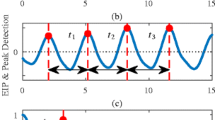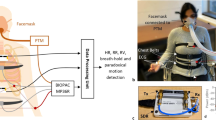Abstract
Respiratory monitoring is increasingly used in clinical and healthcare practices to diagnose chronic cardio-pulmonary functional diseases during various routine activities. Wearable medical devices have realized the possibilities of ubiquitous respiratory monitoring, however, relatively little attention is paid to accuracy and reliability. In previous study, a wearable respiration biofeedback system was designed. In this work, three kinds of signals were mixed to extract respiratory rate, i.e., respiration inductive plethysmography (RIP), 3D-acceleration and ECG. In-situ experiments with twelve subjects indicate that the method significantly improves the accuracy and reliability over a dynamic range of respiration rate. It is possible to derive respiration rate from three signals within mean absolute percentage error 4.37% of a reference gold standard. Similarly studies derive respiratory rate from single-lead ECG within mean absolute percentage error 17% of a reference gold standard.
Similar content being viewed by others
References
YOUNES M. Role of respiratory control mechanisms in the pathogenesis of obstructive sleep disorders [J]. J Appl Physiol, 2008, 105: 1389–1405.
PATEL S, MANCINELLI C, BONATO P, HEALEY J, MOY M. Using wearable sensors to monitor physical activities of patients with COPD: A comparison of classifier performance [J]. Wearable and Implantable Body Sensor Networks, 2009: 234–239.
LIU G Z, HUANG B Y, WANG L. A wearable respiratory biofeedback System based on generalized body sensor network [J]. Telemedicine and E-health, 2011, 17(5): 348–357.
KHALED Z, FARGES G. First approach for respiratory monitoring by amplitude demodulation of the electrocardiogram [C]// Proc 14th Annu Int Conf IEEE Engineering in Medicine and Biology Society. Paris, France, 1992: 2535–2536
MASON C, TARASSENKO L. Quantitative assessment of respiratory derivation algorithms [C]// Proc 14th Annu Int Conf IEEE Engineering in Medicine and Biology Society. Istanbul, Turkey, 2001: 1998–2001.
ROCHE F, PICHOT V, SFORZA E, COURT-FORTUNE I, DUVERNEY D, COSTES F, GARET M, BARTHELEMY J C. Predicting sleep apnoea syndrome from heart period: A time-frequency wavelet analysis [J]. Eur Respir J, 2003, 22: 937–942.
RAYMOND B, CAYTOM R, BATES R, CHAPELL M. Screening for obstructive sleep apnoea based on the electrocardiogram-The computers in cardiology challenge [C]// 27th Annual Meeting of Computers in Cardiology. Cambridge, MA, 2000: 267–270.
SCHRADER M, ZYWIETZ C, von EINEM V, WIDIGER B, JOSEPH G. Detection of sleep apnea in single channel ECGs from the PhysioNet data base [C]// 27th Annual Meeting of Computers in Cardiology. Cambridge, MA, 2000: 263–266.
BOYLE J, BIDARGADDI N, SARELA A, KARUNANITHI M. Automatic Detection of Respiration Rate From Ambulatory Single-Lead ECG [J]. IEEE Trans Information and Technology in Biomedicine, 2009, 13: 890–896.
MACK D C, PATRIE J T, SURATT P M, FELDER R A, ALWAN M. Development and preliminary validation of heart rate and breathing rate detection using a passive, ballistocardiography-based sleep monitoring system [J]. IEEE Transactions on Information Technology in Biomedicine, 2009, 13(1): 111–120.
NAM S H, YIM T C, et al. The preliminary study of unobtrusive respiratory monitoring for e-health [C]// 27th Annual International Conference of the IEEE Engineering in Medicine and Biology Society. Shanghai, China, 2005: 3796–3798.
ZHANG Z B, WANG W D, WANG B Q, WU H, LIU H Y, ZHANG Y K. A prototype of wearable respiration biofeedback platform and its preliminary evaluation on cardiovascular variability [C]// 3rd International Conference on Bioinformatics and Biomedical Engineering (ICBBE 2009). Beijing, China, 2009: 1397–1400.
WU D, WANG L, ZHANG Y T. A wearable respiration monitoring system based on digital respiratory inductive plethysmography [C]// Conf 2009 IEEE Engineering in Medicine and Biology Society, 2009: 4844–4847.
HUNG P D, BONNET S, GILLEMAUD R, CASTELLI E, YEN P T N. Estimation of respiratory waveform using an accelerometer [C]// 30th Annual International Conference of the IEEE Engineering-in-Medicine-and-Biology-Society. Vancouver, Canada, 2008: 1493–1496.
BATES A, LING M J, MANN J, ARVIND D K. Respiratory rate and flow waveform estimation from tri-axial accelerometer data [C]// 2010 International Conference on Body Sensor Networks (BSN). Singapore, Singapore, 2010: 144–150.
ANMIN J, BIN Y, GEERT M, HARIS D. Performance evaluation of a tri-axial accelerometry-based respiration monitoring for ambient assisted living [C]// 31st Annual International Conference of the IEEE Engineering in Medicine and Biology Society. EMBC 2009, Minneapolis, MN, USA, 2009: 5677–5680.
DASH S, SHELLEY K H, SIVERMAN D G, CHON K H. Estimation of respiratory rate from ECG, photoplethysmogram, and piezoelectric pulse transducer signals: A comparative study of time-frequency methods [J]. IEEE Trans Biomedical Engineering, 2010, 57(5):.
FIAMMA M N, SAMARA Z, BACONNIER P, SIMILOWSK T, STRAUS C. Respiratory inductive plethysmography to assess respiratory variability and complexity in humans [J]. Respiratory Physiology & Neurobiology, 2007, 156(2): 234–239.
WU D, LIU G Z, WONG M Y M, ZHANG Y T. The accuracy of respiratory rate estimation using electrocardiography and photoplethysmography [C]// 10th IEEE International Conference on Information Technology and Applications in Biomedicine (ITAB 2010). Corfu, Greece, 2010: 1–4.
LIN S J, WANG L, HUANG B Y, ZHANG Y T, WU X M, ZHAO J P. A pilot study on BSN-based ubiquitous energy expenditure monitoring [C]// Conference of 2009 IEEE Body Sensor Networks, 2009: 1–4.
DUDA R O, HART P E, STORK D G. Pattern classification [M]. 2nd Edition. Beijing: China Machine Press and Citic Publishing House, 2003: 568–569.
Author information
Authors and Affiliations
Corresponding author
Additional information
Foundation item: Project(2012M510207) supported by the China Postdoctoral Science Foundation; Projects(60932001, 61072031) supported by the National Natural Science Foundation of China; Project(2012AA02A604) supported by the National High Technology Research and Development Program of China; Project (2013ZX03005013) supported by the Next Generation Communication Technology Major Project of National Science and Technology, China; Project supported by the “One-hundred Talent” and the “Low-cost Healthcare” Programs of Chinese Academy of Sciences
Rights and permissions
About this article
Cite this article
Liu, Gz., Wu, D., Mei, Zy. et al. Automatic detection of respiratory rate from electrocardiogram, respiration induced plethysmography and 3D acceleration signals. J. Cent. South Univ. 20, 2423–2431 (2013). https://doi.org/10.1007/s11771-013-1752-z
Received:
Accepted:
Published:
Issue Date:
DOI: https://doi.org/10.1007/s11771-013-1752-z




